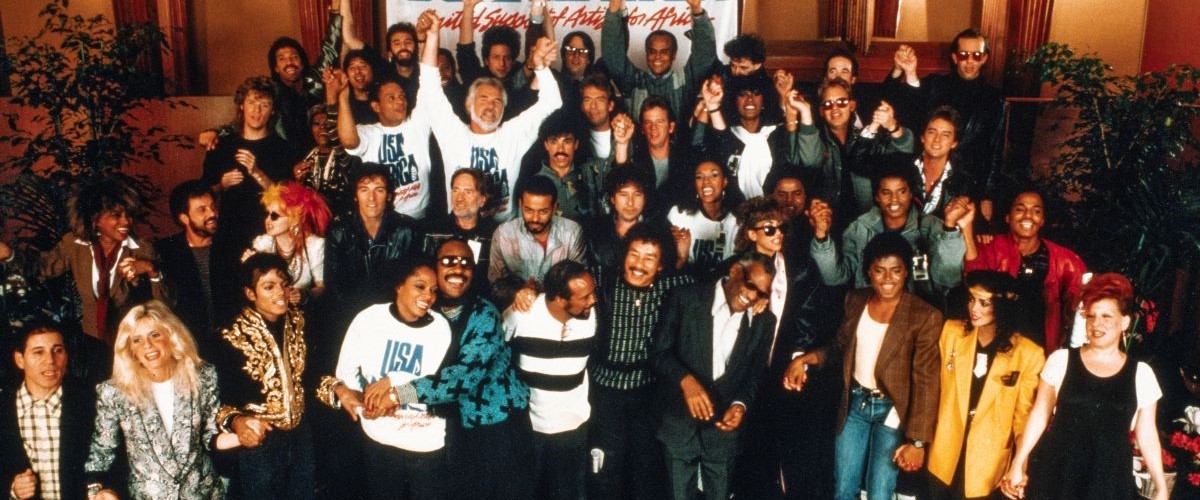
“We Are the World” is such a staple, such a part of our collective cultural DNA, that it seems as though it arrived fully formed in all its anthemic, cast-of-superstars glory.
Of course, that wasn’t the case. Assembling all those pop legends required a herculean effort—and first they had to write the song.
Through interviews and priceless behind-the-scenes footage, Bao Nguyen’s documentary, The Greatest Night in Pop, reveals just how that song came together on that one fateful night in 1985. It’s narrated by a bunch of pop luminaries, most notably Lionel Richie, who co-wrote the song with Michael Jackson and proves to be an excellent raconteur. Also interviewed are Cyndi Lauper, Kenny Loggins, Huey Lewis, producer Quincy Jones, and various music execs and tech people. Most shockingly, Bruce Springsteen is interviewed—he somehow seems both proud of the project and slightly mortified by his involvement. (It’s clear The Boss found the song corny.)
The concept was cribbed from Bob Geldof’s “Do They Know It’s Christmas?”, which had every New Wave British singer you can think of (including Sting, Bono, and my forever crush, Duran Duran’s John Taylor) and raised money to combat famine in Ethiopia. Inspired by Geldof’s success and icon Harry Belafonte’s involvement in the same cause, Richie and co. set out to do an American version.
Richie, who met Michael Jackson, then at the peak of his “Thriller” success, at his home to write the song, shares colorful stories about encountering Michael’s various exotic pets: There was Bubbles the chimp, a talking parrot, and a giant python, which was a bridge too far. (Richie bolted.)
Michael didn’t play any instruments, but instead hummed the song he heard in his head, as Richie interpreted it on piano. They had to construct a song that was catchy, uplifting, and allowed for a variety of disparate voices. It’s safe to say they succeeded.
With the involvement of Richie, Jackson, Stevie Wonder (an early sign-on), and Quincy Jones, it was fairly easy to recruit the biggest stars of the day. One after the other they said yes—Paul Simon, Tina Turner, Diana Ross, Billy Joel, Steve Perry from Journey, Willie Nelson—and so on. But even they were surprised when first Bruce Springsteen and then Bob Dylan signed on. These were iconoclastic rockers, not exactly known to be joiners.
They smartly chose to record the song all in one session, the day after the American Music Awards—when everyone was already in town. They all assembled in an LA recording studio, where the words “Leave Your Ego At the Door” were hastily taped to window. It was necessary.
One thing you have to understand about “We Are the World” is that not everyone got a solo. The biggest stars did, although Richie and Jones had to tap dance around that reality by saying it was based on vocal range. Still, some of the stars who didn’t get solos were salty. (Not sure how they could be when Bette Midler herself didn’t get one.)
The percussionist and singer Sheila E, then Prince’s girlfriend, was on hand and called her beau, telling him he was missing out, he had to get there. Briefly, there was an excited buzz that Prince was actually going to show—imagine having both Prince and Michael Jackson in the same recording studio—but Prince never made it. Sheila E wasn’t surprised. She said Prince was shy.
So, at the last minute, Huey Lewis was asked to fill in for Prince on the vocal solos. Lewis, who is extremely endearing in his interviews, said he was excited and petrified. He was truly afraid he was going to lay an egg in front of all his heroes.
Cyndi Lauper also seemed a bit intimidated by the crowd of icons—who were mostly older and more established than her. When she did her solo, she feared they were laughing at her. They explained that they were laughing at the fact that her enormous earrings and stacked necklaces, her signature style, were rattling on the mic. She sheepishly removed them and belted out her verse with her patented raspy alto.
Despite the undercurrent of jealousy, there was much conviviality in the studio, and an understanding that what was transpiring was truly extraordinary. But as the night wore on—and turned to morning—people inevitably got cranky and tired and sweaty.
“The room was ripe,” one sound engineer said.
For the most part, Quincy Jones, with help from Richie, managed to keep the group on track.
Among the singers, some were more used to this kind of pop anthem than others—but no one was more out of place than Dylan, who looked hilariously miserable and out of sorts for most of the recording.
Indeed, when it was his turn to sing, he wasn’t as mic-ready as others, and seemed a bit baffled as to what was expected of him. Stevie Wonder emerged to save the day, in an ingenious way you’ll have to watch the doc to find out.
The Greatest Night in Pop is one of those wonderfully wish fulfilling, “man I wish I could’ve been a fly on the wall during that recording”-type documentaries. I want to watch it again just to take in all the background activity (stars hugging and laughing and whispering in each other’s ears) that I missed. But wonderful as the doc is, it still doesn’t answer one of the greatest mysteries of them all, up there with Stonehenge and the Bermuda Triangle: What on earth was Dan Aykroyd doing there?
The Greatest Night in Pop is now playing on Netflix.
